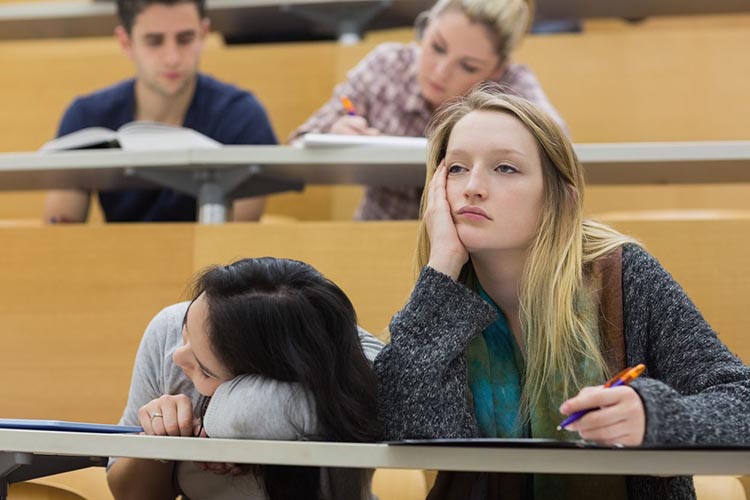
Colleges scramble to give extra support to sophomores whose first college year was disrupted by Covid-19
From The Hechinger Report
By Olivia Sanchez
August 19, 2021
Mariah Davis moved from Farmington Hills, Michigan, to St. Louis to begin her freshman year at Washington University last year, but she took all but one of her courses on Zoom from her dorm room. She said she feels like her class is sophomore in name only, because of the experiences they missed out on during the COVID-19 pandemic. When school starts this fall, she will have to get comfortable with things like taking notes during real-time, in-person lectures, and meaningfully socializing with people outside her suite.
Most of her classmates were on campus for part of the year, but some, including international students who struggled to get visas during the pandemic, took classes remotely the whole year.
This fall, they will all return to campus as vaccinated sophomores with almost no concept of what an on-campus college experience is typically like.
“What made it difficult wasn’t having to wear a mask or having to social distance, in themselves, but just feeling like you were so disconnected and feeling like a loneliness because you couldn’t really see people and you couldn’t really get that human connection,” Davis said.
Aware of this, the college designed a sophomore-specific orientation program. The goal is not to recreate what should have happened during the students’ freshman orientation, but instead to fill in information gaps related to academic resources and campus life, and help them build community, said Dacoda Scarlett, a coordinator in Washington University’s First Year Center. Students will share meals, attend information sessions with different academic and college services departments, venture beyond the campus bubble into the city of St. Louis and ultimately have the opportunity to spend time getting to know each other.
Many students in the class of 2024 had their high school experience cut short in 2020, missing prom and graduation, and went on to a freshman year that was either fully remote or required them to spit in a test tube before moving into the dorms, where they lived relatively isolated lives to prevent the spread of the virus. As colleges and universities attempt to return to some semblance of normal this year, many are scrambling to find ways to engage sophomores and help them find their on-campus communities.
Like Washington University, Franklin & Marshall College in Lancaster, Pennsylvania, is offering second-year students the chance for a do-over orientation program before school starts.
Beth Throne, associate vice president for student and post-graduate development at Franklin & Marshall, said last year’s freshmen came aboard while the college was still figuring out how to operate safely and efficiently amid the pandemic. Typical new-student orientation material was tossed out and instead, students were given guidance on how to succeed despite all the “constraints on spacing and mobility and other necessary precautions because of that virus,” she said.
At Stevens Institute of Technology in Hoboken, New Jersey, Sara Klein, assistant vice president for student affairs, said she’s been thinking about what they could do for these students since this time last year. Stevens is calling its program ReOrientation.
“Last year, as we were reopening the campus for the small group of students who came, I would say it kind of in passing to people, ‘We’re going to make this up to you, this is not going to be your only option for an orientation,’” Klein said. Because she has been hearing that many students still feel isolated, “most of the focus is on social. They need to find other students who are people they would like to hang out with, they need to also meet returning students to connect into student organizations and other aspects of university life.”
At Stanford University in California, a sophomore-specific weekly newsletter acts as guide to campus services and their move-in weekend will feature a scavenger hunt around the Bay Area to help them bond and become more familiar with their surroundings.
“This was really a period of transition for everyone involved,” said Orlando T. White, associate dean of residential education at Stanford. The university operated remotely last year.
Now that the student body is coming back to Palo Alto, White said, “What do we do to make sure that, once they arrive on campus, they feel welcomed and supported, recognizing those challenges and not just pretending that we’re flipping a switch?”
Like Stanford, Loyola University New Orleans launched a sophomore experience newsletter. It tackles subjects ranging from “sophomore slump” to internship opportunities and campus deadline reminders.
First- and second-year students at Loyola now have access to a program called NearPeer, a peer-to-peer networking tool that students can use to find others with similar interests and goals, seek mentors or join student groups.
Tanner Smith, a rising sophomore at Washington University, said he had made friends in masked, socially distanced small groups last year, but it was difficult.
“It definitely degraded my mental stability,” he said, “having been locked up and not seeing other people and not getting socialized, having the weird zoom classroom atmosphere where nobody ever speaks up and teachers just pander until whenever the class is over.”
The university is requiring vaccines – a safety measure that will allow students freedoms they didn’t have last year, including attending classes in person and visiting residence halls they don’t live in. Smith said he hopes this will allow him to make friends with people who aren’t his direct neighbors.
“I don’t know what my class looks like at all,” Smith said. “And I’d like to know who my peers are.”
Photo: Verywell Family
Read this and other stories at The Hechinger Report

